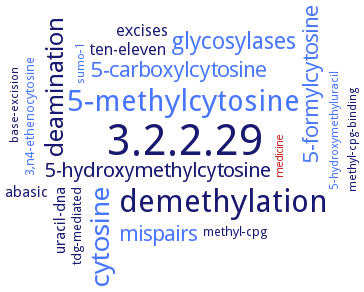3.2.2.29: thymine-DNA glycosylase
This is an abbreviated version!
For detailed information about thymine-DNA glycosylase, go to the full flat file.

Word Map on EC 3.2.2.29 
-
3.2.2.29
-
demethylation
-
5-methylcytosine
-
cytosine
-
deamination
-
glycosylases
-
5-carboxylcytosine
-
mispairs
-
5-formylcytosine
-
5-hydroxymethylcytosine
-
ten-eleven
-
excises
-
uracil-dna
-
abasic
-
methyl-cpg
-
3,n4-ethenocytosine
-
tdg-mediated
-
5-hydroxymethyluracil
-
sumo-1
-
base-excision
-
methyl-cpg-binding
-
medicine
- 3.2.2.29
-
demethylation
- 5-methylcytosine
- cytosine
-
deamination
- glycosylases
- 5-carboxylcytosine
- mispairs
- 5-formylcytosine
-
5-hydroxymethylcytosine
-
ten-eleven
-
excises
-
uracil-dna
-
abasic
-
methyl-cpg
- 3,n4-ethenocytosine
-
tdg-mediated
- 5-hydroxymethyluracil
- sumo-1
-
base-excision
-
methyl-cpg-binding
- medicine
Reaction
Hydrolyses mismatched double-stranded DNA and polynucleotides, releasing free thymine. =
Synonyms
G/T glycosylase, G:T mismatch-specific thymine DNA-glycosylase, hsTDG, hTDG, mismatch-specific thymine-DNA glycosylase, mismatch-specific thymine-DNA N-glycosylase, More, Pa-MIG, T/U mismatch DNA glycosylase, T:G mismatch-specific thymidine-DNA glycosylase, TDG, Thd1p, thymine DNA glycosylase, thymine DNA-glycosylase, thymine-DNA glycosylase, uracil/thymine DNA glycosylase
ECTree
Advanced search results
Activating Compound
Activating Compound on EC 3.2.2.29 - thymine-DNA glycosylase
Please wait a moment until all data is loaded. This message will disappear when all data is loaded.
SUMO-1
TDG interacts with, but also is modified by SUMO-1 and SUMO-3, SUMOs are small ubiquitin like modifiers, small polypeptides structurally related to ubiquitin that interact with and/or are attached to other proteins. SUMO conjugation involves Lys330 located in a C-terminal SUMOylation consensus motif, VKEE, it is ATP-dependent and, when performed in cell extracts, stimulated by the presence of DNA. SUMO attachment to K330 affects structural and enzymatic properties of TDG. The modified glycosylase is not longer able to interact with free SUMO or SUMO-conjugated proteins, or to bind stably to AP-sites or any other DNA. Yet, it processes a G-U substrate with enhanced efficiency due to an induced enzymatic turnover but, at the same time, loses its ability to hydrolyze T from a G-T substrate
-
SUMO-3
TDG interacts with, but also is modified by SUMO-1 and SUMO-3, SUMOs are small ubiquitin like modifiers, small polypeptides structurally related to ubiquitin that interact with and/or are attached to other proteins. SUMO conjugation involves Lys330 located in a C-terminal SUMOylation consensus motif, VKEE, it is ATP-dependent and, when performed in cell extracts, stimulated by the presence of DNA. SUMO attachment to K330 affects structural and enzymatic properties of TDG. The modified glycosylase is not longer able to interact with free SUMO or SUMO-conjugated proteins, or to bind stably to AP-sites or any other DNA. Yet, it processes a G-U substrate with enhanced efficiency due to an induced enzymatic turnover but, at the same time, loses its ability to hydrolyze T from a G-T substrate
-
AP andonuclease 1 is able to stimulate the turnover of TDG on a G/T substrate
-
additional information
the enzyme can be stimulated by human AP endonuclease 1
-
additional information
-
the enzyme can be stimulated by human AP endonuclease 1
-


 results (
results ( results (
results ( top
top






